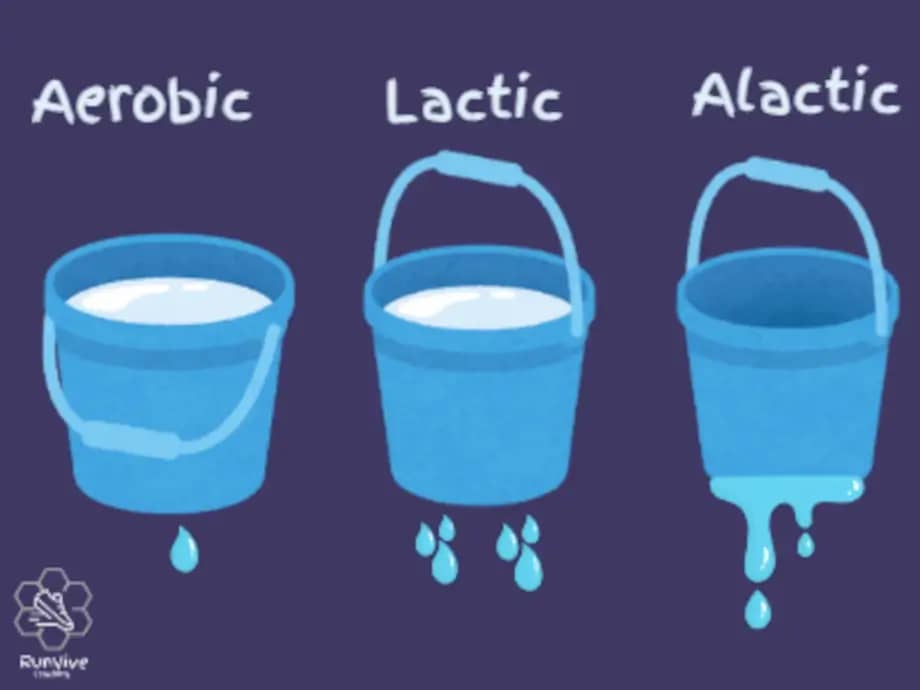
The easy run is the bread and butter of running. The staple miles that fill up the majority of the plan, from beginner to advanced, from 5k to ultra.
For the simplest run that we runners do though, it is easily the most misunderstood.
Before I try and make easy running, well easy, it’s worth understanding why we do it – and why all good coaches and training plans insist on a base building of easy running before getting to the snazzy stuff.
And before we do that, an important word of caution: easy running does not just mean slow running, or slow runners. It is slow er , yes, but slower for you – whatever pace you might be.
Easy running: why do it?
Runners (well humans) have three energy systems. I like to think of them as buckets. All three buckets work continuously, but the intensity and duration of the running will draw on different buckets. When one bucket runs empty, the body needs to draw more heavily on the other buckets. So, they should be considered separately, but recognise as interlinked.

Bucket 1 is your aerobic system. This is your main tank which draws on oxygen and fuel stores to power your running. When you are running aerobically, your muscles have sufficient oxygen to keep going and sufficient fuel stored* for around 1hr 45 mins (although you can top up that fuel storage mid run to go longer).
Imagine a bucket which has one small hole in. It will slowly drain its contents although if you top it up with more water, it will get fuller.
The good news about this bucket is you can train it to get bigger, to drain slower and generally become more efficient to power you for longer or faster (or both). You do that through easy running.
Bucket 2 is your lactic system. This can operate without oxygen, but uses fuel stores and produces lactate – that lovely heavy leg feeling you get at the end of a fast 10k. Often lumped in with bucket 3 as your anaerobic system, this is the predominant system you draw on when pushing between 10 seconds and 2 minute efforts – so intervals around 80m–600m. That’s not to say it’s only involved then, far from it – see end of 10k point – but that’s when it’s mainly bucket 2.
In terms of our buckets, this one has more holes in so drains much quicker. When doing lactic work, you want a decent size recovery between intervals to allow your bucket to refill; part filling it will just lead to it quickly emptying.
Bucket 3 is your alactic system: This is your start up system – your 10 seconds’ boost. Imagine a bucket that has a sliding bottom. You pour liquid in and when you pull the base, it flows straight out. Once you’ve drained it, it takes a long time to fill back up. These 10 seconds are a phenomenally handy burst of pure speed but need to be deployed sparingly – at the start of a cross-country race to get a position or at the end of a race as a boost.

While the alactic and lactic systems often get the attention, that bucket 1 – your reliable, go-to bucket – is the main energy system involved in endurance running:
- For a 1 mile race, 80% of your running is aerobic.
- For a 5k, 84%.
- For a 10k, 90% for men – 95% for women.
And for half-marathons and marathons, nearly 99% of the energy contribution is aerobic.
Building your aerobic base means you can get your muscles and skeleton used to the impact of running and provides you the base to build your lactic and alactic systems. That’s why advanced athletes can get away with more work in these two systems, because they’ve already done the base work. And that is why it’s so important to choose plans based on where you are, and not where you think you are, to give your body the time to adapt.

How to “do” easy running?
So far so…bucket filling. But we still have the problem of understanding what an easy run is. Considering it’s called “easy” – it’s actually pretty difficult to get right. Here are some different tools you can use to test whether your running is truly easy:
- Rate of Perceived Effort (RPE) : On a scale of 1-10, with 1 being a gentle stroll and 10 being running for your life from a bear, the easy run should fall between 3-4.
- Heart rate : Many watches will give you your predicted heart rate span or you can wear a chest strap for greater accuracy – zone 1 or 2 depending on the scale you use. The rule of thumb is 60-70% of your max heart rate. How do you know your max heart rate? Deduct your age from 220. Or look at your heart rate when you’ve been chased by a bear (or completed a hard 5k, interval session etc)
- Pace: There are calculators which you can use based off a recent race. For instance, a 1 hour 10k runner’s easy pace will be 10:54 – 13:11 mins/mile. Different calculators do use different formulas, but will be broadly in the same area.
Each tool has its own pros/cons. RPE is difficult to judge while you’re starting out with it, but when you have tuned in has the benefit of being entirely personalised to you. HR can fluctuate wildly, and if you rely on your watch, is notoriously inaccurate. Pace doesn’t take into account your stress levels that day, the temperature, whether you’d been chased by a bear that morning – all things which will make a run feel less easy than it should be.
If you’re a beginner (less than 12 months consistent running), it’s even harder as your easy will not be easy as someone who has been running much longer. Your bucket is a bit smaller. So, when you read highly intelligent and well thought-out articles like this one (ahem), take it into account that most are written for people who have a solid running background. If you’re a beginner runner, your easy heart rate will likely be 75% of your max, because your body is working harder to adjust to the concept of running. Keep going, you are doing it right. It just takes time.

Where problems arise is when runners fixate on the quantitative details over their qualitative findings – i.e. numbers over feeling. Getting their heart rate to within one beat of where it needs to be or slowing down to such a pace it’s uncomfortable, because that’s what the pace calculator says to do. Remember, they are just tools – things to use to guide you.
The simplest test is that if it feels easy, then it will be easy. If you’re running so slow it’s impacting your biomechanics (i.e. form), then it’s not easy – it’s difficult. If you’re finding yourself stressing that your heart rate will just not come down, or losing the love of running because you’re so conscious at running slower – it’s not easy, it’s frustrating.
Next time you see “easy” on your plan, keep half an eye on your watch heart rate and if it’s 10-20 beats over where you need it to be, slow down. If you’re finding it difficult to slow down, try running your normal pace, but break it up with a 1 min walk every 4 minutes. Or run with a friend who is a bit slower – just don’t make them speed up so their run is harder.
But ultimately, just go easy on yourself.
*For more on fuel source, check out my blog on carb loading folklore: Carb loading folklore (runvive.co.uk)


